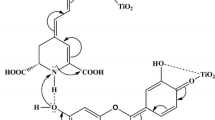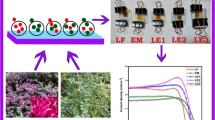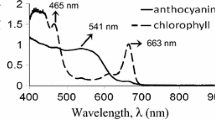Abstract
This work reports the novel contribution of chlorophyll b as natural anthocyanin co-pigment in unpurified black rice extract for improved electron transport and performance of natural dye-sensitized solar cell. The dyes are extracted as prominent photosensitizers by considering the concentration, the dye electronic structure, the extraction, and immersion time. The anthocyanin dye containing 1.92 mM cyanidin-3-O-glucoside structure has been extracted without purification. Interestingly, 0.33 mM chlorophyll b is found as a natural co-sensitizer in unpurified anthocyanin. The role of chlorophyll b supporting the electron transfer of anthocyanin dye will be investigated for improved cell performance. Both purified and unpurified dyes are compared in the same anthocyanin concentration. The combined Tauc plot and voltametric method will be conducted to show the interfacial electronic band edges of TiO2-dye-electrolyte. Electrochemical impedance spectroscopy method will investigate electron transfer dynamic in both cell systems. As a result, chlorophyll b has dominantly acted as two intermediate states in boosting electron injection and dye regeneration to improve cell efficiency from 1.31 to 2.17 % due to the narrower LUMO–TiO2 conduction band gap and the narrower HOMO-iodide (I −) potential gap, respectively. According to the electron transport, the co-sensitizer contributes to the smaller transport resistance (R t = 21.9 Ω), the higher chemical diffusion coefficient (Dn = 1.696 × 10−3 cm2/s), the higher chemical capacitance (Cμ = 14.32 μF), and the faster electron transport (τd = 39.88 μs).








Similar content being viewed by others
References
Calogero G, Bartolotta A, Di Marco G, Di Carlo A, Bonaccorso F (2015) Vegetable-based dye-sensitized solar cells. Chem Soc Rev 44:3244–3294
Prima EC, Yuliarto B, Suendo V, Suyatman (2014) Improving photochemical properties of Ipomea pescaprae, Imperata cylindrica (L.) Beauv, and Paspalum conjugatum Berg as photosensitizers for dye sensitized solar cells. J Mater Sci Mater Electron 25:4603–4611
Cahya Prima E, Yuliarto B, Kresno Dipojono H (2015) Theoretical investigation of anthocyanidin aglycones as photosensitizers for dye-sensitized TiO2 solar cells. Adv Mat Res 1112:317–320
Bridle P, Timberlake CF (1997) Anthocyanins as natural food colours—selected aspects. Food Chem 58:103–109
Park YS, Kim SJ, Chang HI (2008) Isolation of anthocyanin from black rice (Heugjinjubyeo) and screening of its antioxidant activities. Korean J Microbiol Biotechnol 36:55–60
Yuliarto B, Septina W, Fuadi K, Fanani F, Muliani L, Nugraha (2010) Synthesis of nanoporous TiO2 and its potential applicability for dye-sensitized solar cell using antocyanine black rice. Adv Mater Sci Eng. doi:10.1155/2010/789541
Hao S, Wu J, Huang Y, Lin J (2006) Natural dyes as photosensitizers for dye-sensitized solar cell. Sol Energy 80:209–214
Yuliza E, Saehana S, Rahman DY, Rosi M, Mikrajuddin A (2013) Enhancement performance of dye-sensitized solar cells from black rice as dye and black ink as counter electrode with inserting copper on the space between TiO2 particles by using electroplating method. Mater Sci Forum 737:85–92
Saehana S, Yuliza E, Arifin P, Abdullah M (2013) Dye-sensitized solar cells (dssc) from black rice and its performance improvement by depositing interconnected copper (Copper Bridge) into the space between TiO2 nanoparticles. Mater Sci Forum 737:43–53
Buraidah MH, Teo LP, Yusuf SNF, Noor MM, Kufian MZ, Careem MA (2011) Arof AK (2011) TiO2/chitosan NH4I(+I2)-BMII-based dye-sensitized solar cells with anthocyanin dyes extracted from black rice and red cabbage. Int J Photoenergy. doi:10.1155/2011/273683
Chien CY, Hsu BD (2013) Optimization of the dye sensitized solar cell with anthocyanin as photosensitizer. Sol Energy 98:203–211
Adhyaksa GWP, Prima EC, Lee DK, Ock I, Yatman S, Yuliarto B, Kang JK (2014) A light harvesting antenna using natural extract graminoids coupled with plasmonic metal nanoparticles for bio-photovoltaic cells. Adv Energy Mater 4:1400470. doi:10.1002/aenm.201400470
Gómez-Ortíz NM, Maldonado IAV, Espadas ARP, Rejoń GJM, Barrios JAA, Oskama G (2010) Dye-sensitized solar cells with natural dyes extracted from Achiote seeds. Sol Energy Mater Sol Cells 94:40–44
Zhou H, Wu L, Gao Y, Ma T (2011) Dye-sensitized solar cells using 20 natural dyes as sensitizers. J Photochem Photobiol, A 219:188–194
Tadesse S, Abebe A, Chebude Y, Garcia IV, Yohannes T (2012) Natural dye-sensitized solar cells using pigments extracted from Syzygium Guineense. J Photon Energy 2:027001–1. doi:10.1117/1.JPE.2.027001
Furukawa S, Lino H, Iwamoto T, Kukita K, Yamauchi S (2009) Characteristics of dye-sensitized solar cells using natural dye. Thin Solid Films 518:526–529
Chang H, Lo YJ (2010) Pomegranate leaves and mulberry fruit as natural sensitizers for dye-sensitized solar cells. Sol Energy 84:1833–1837
Kumara NTRN, Ekanayake P, Lim A, Liew LYC, Iskandar M, Ming LC, Senadeera GKR (2013) Layered co-sensitization for enhancement of conversion efficiency of natural dye sensitized solar cells. J Alloys Compd 581:186–191
Park KH, Kim TY, Park JY, Jin EM, Yim SH, Fisher JG, Lee JW (2013) Photochemical properties of dye-sensitized solar cell using mixed natural dyes extracted from Gardenia Jasminoide Ellis. J Electroanal Chem 689:21–25
Kirchhoff H, Hinz HJ, Rösgen J (2003) Aggregation and fluorescence quenching of chlorophyll a of the light-harvesting complex II from spinach in vitro. Biochim Biophys Acta 1606:105–116
Wang XF, Zhan CH, Maoka T, Wada Y, Koyama Y (2007) Fabrication of dye-sensitized solar cells using chlorophylls c1 and c2 and their oxidized forms and from Undaria pinnatifida (Wakame). Chem Phys Lett 447:79–85
Calogero G, Citro I, Crupi C, Di Marco G (2014) Absorption spectra and photovoltaic characterization of chlorophyllins as sensitizers for dye-sensitized solar cells. Spectrochim Acta A Mol Biomol Spectrosc 132:477–484
Yu D, Zhu G, Liu S, Ge B, Huang F (2013) Photocurrent activity of light-harvesting complex II isolated from spinach and its pigments in dye-sensitized TiO2 solar cell. Int J Hydro Energy 38:16740–16748
Calogero G, Yum JH, Sinopoli A, Di Marco G, Grätzel M, Nazeeruddin MK (2012) Anthocyanins and betalains as light-harvesting pigments for dye-sensitized solar cells. Sol Energy 86:1563–1575
Argyroudi-Akoyunoglou JH, Akoyunoglou G (1970) Photoinduced changes in the chlorophyll a to chlorophyll b ratio in young bean plants. Plant Physiol 46:247–249
Eads DD, Castner EW Jr, Alberte RS, Mets L, Fleming GR (1989) Direct observation of energy transfer in a photosynthetic membrane: chlorophyll b to chlorophyll a transfer in LHC. J Phys Chem 93:8271–8275
Inskeep WP, Bloom PR (1985) Extinction coefficients of chlorophyll a and b in N, N-dimethylformamide and 80% acetone. Plant Physiol 77:483–485
Kay A, Graetzel M (1993) Artificial photosynthesis. 1. Photosensitization of titania solar cells with chlorophyll derivatives and related natural porphyrins. J Phys Chem 97:6272–6277
Kay A, Humphry-Baker R, Graetzel M (1994) Artificial photosynthesis. 2. Investigations on the mechanism of photosensitization of nanocrystalline TiO2 solar cells by chlorophyll derivatives. J Phys Chem 98:952–959
Ordaz-Galindo A, Wesche-Ebeling P, Wrolstad RE, Rodriguez-Saona L, Argaiz-Jamet A (1999) Purification and identification of Capulin (Prunus serotina Ehrh) anthocyanins. Food Chem 65:201–206
Wrolstad RE, Durst RW, Lee J (2005) Tracking color and pigment changes in anthocyanin products. Trends Food Sci Tech 16:423–428
Eijckelhoff C, Dekker JP (1997) A routine method to determine the chlorophyll a, pheophytin a and β-carotene contents of isolated photosystem II reaction center complexes. Photosynth Res 52:69–73
Bredas JL, Silbey R, Boudreaux DS, Chance RR (1983) Chain-length dependence of electronic and electrochemical properties of conjugated systems: polyacetylene, polyphenylene, polythiophene, and polypyrrole. J Am Chem Soc 105:6555–6559
Lim A, Kumara NTRN, Tan AL, Mirza AH, Chandrakanthi RLN, Petra MI, Ekanayake P (2015) Potential natural sensitizers extracted from the skin of Canarium odontophyllum fruits for dye-sensitized solar cells. Spectrochim Acta A 138:596–602
Kumara NTRN, Kooh MRR, Lim A, Petra MI, Voo NY, Lim CM, Ekanayake P (2013) DFT/TDDFT and experimental studies of natural pigments extracted from black tea waste for DSSC application. Int J Photoenergy. doi:10.1155/2013/109843
Tauc J, Grigorovici R, Vancu A (1966) Optical properties and electronic structure of amorphous germanium. Phys Stat Sol 15:627–636
Wu J, Lan Z, Lin J, Huang M, Huang Y, Fan L, Luo G (2015) Electrolytes in dye-sensitized solar cells. Chem Rev 115:2136–2173
Bisquert J, Vikhrenko VS (2002) Analysis of the kinetics of ion intercalation. Two state model describing the coupling of solid state ion diffusion and ion binding processes. Electrochim Acta 47:3977–3988
Bisquert J (2002) Theory of the impedance of electron diffusion and recombination in a thin layer. J Phys Chem B 106:325–333
Bisquert J (2004) Chemical diffusion coefficient of electrons in nanostructured semiconductor electrodes and dye-sensitized solar cells. J Phys Chem B 108:2323–2332
Bisquert J, Compte A (2001) Theory of the electrochemical impedance of anomalous diffusion. J Electroanal Chem 499:112–120
Bisquert J, Fabregat-Santiago F, Mora-Seró I, Garcia-Belmonte G, Giménez S (2009) Electron lifetime in dye-sensitized solar cells: theory and interpretation of measurements. J Phys Chem C 113:17278–17290
Bisquert J, Garcia‐Belmonte G, Pitarch Á (2003) An explanation of anomalous diffusion patterns observed in electroactive materials by impedance methods. ChemPhysChem 4:287–292
Warburg E (1901) Ueber die polarisationscapacität des platins. Ann Phys 311:125–135
Lim A, Haji Manaf N, Tennakoon K, Chandrakanthi RLN, Lim LBL, Bandara JMR, Ekanayake P (2015) Higher performance of DSSC with dyes from Cladophora sp. as mixed cosensitizer through synergistic effect. J Biophys. doi:10.1155/2015/510467
San Esteban ACM, Enriquez EP (2013) Graphene–anthocyanin mixture as photosensitizer for dye-sensitized solar cell. Sol Energy 98:392–399
Nguyen VH, Chan HY, Wu JC (2013) Synthesis, characterization and photo-epoxidation performance of Au-loaded photocatalysts. J Chem Sci 125:859–867
Seo DK, Hoffmann R (1999) Direct and indirect band gap types in one-dimensional conjugated or stacked organic materials. Theor Chem Acc 102:23–32
Acknowledgments
The research underlying this paper is partially supported by Penelitian Unggulan Perguruan Tinggi (2016) and Penprinas MP3EI (2013–2015), National Innovation System (SINAS) Research Incentive Program Kementerian Riset, Teknologi, dan Pendidikan Tinggi Republik Indonesia (RT-2014-741), KK Research and Innovation Program, Institut Teknologi Bandung (2014), and Ikatan Alumni ITB Research Grant (2014–2015).
Author information
Authors and Affiliations
Corresponding author
Rights and permissions
About this article
Cite this article
Prima, E.C., Al Qibtiya, M., Yuliarto, B. et al. Influence of anthocyanin co-pigment on electron transport and performance in black rice dye-sensitized solar cell. Ionics 22, 1687–1697 (2016). https://doi.org/10.1007/s11581-016-1673-6
Received:
Revised:
Accepted:
Published:
Issue Date:
DOI: https://doi.org/10.1007/s11581-016-1673-6




